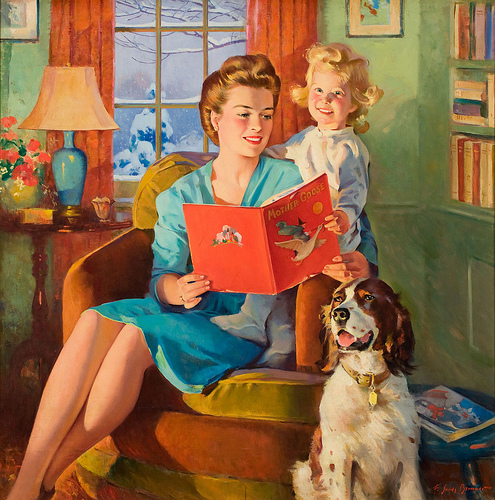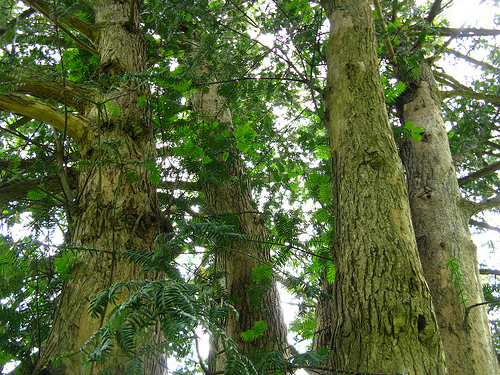What Hasn't Changed

Our society is addicted to the idea of progress. We're prone to think technological change fundamentally alters the way we do things. In reality, the fundamentals tend to endure through the ebb and flow of technological adoption.
Zappos isn't the first company to provide stellar service, and the conversations that take place on Yelp used to take place around the water cooler. As marketers, we can sometimes learn more by analyzing what hasn't changed rather than what has. There's a lot of talk about tactics and tools these days, but lets get back to fundamentals. Strategy is king.
picture from http://www.flickr.com/photos/spursfan_ace/2328879637/
The Setting For Good Stories and Brands

Just like novels, the story of every successful brand has a setting. There's a specific time and a unique set of circumstances that allows the brand to become a leader in their industry. Whether that's the creation of a new market, or the dismantling of an old one. Successful brands take full advantage of the opportunities that are presented to them.
What is important about the setting isn't dates or geography, it's the events and circumstances that influence the main characters, or for the sake of our analogy, the brand. For example, on January 11, 1949, in Pittsburgh, Pennsylvania, KDKA-TV went live as the only local on-air television station in Pittsburgh. But, the most important factor of this setting wasn't the time or place, but the fact that KDKA-TV was one of the last television stations to be given construction rights by the FCC before a four year freeze on new licenses.
The Declining Scarcity of Knowledge

Scarcity breeds value. As scarcity decreases, so does value.
For example, traditional boards for the game Go (these boards are called gobans; to learn more about the ancient Chinese strategy game click here) are made from the wood of the rare Kaya tree. You can make a goban out of just about any type of wood, but several features make the wood of the Kaya tree particularly desirable: "beautiful yellow-gold color, fine and uniform ring texture, and the sonic quality of the click of a stone on its surface." Here's the catch: harvesting Kaya trees alive is illegal, and they have to grow several hundred years to reach the width required to craft a goban. Good luck waiting hundreds of years for a tree to die. It doesn't get much scarcer than that, and these pieces of wood are priced accordingly: traditional goban cost upwards of $20,000. (That's about three years at the average four year university.)
On the other end of the scarcity spectrum are social media "gurus". While these experts are particularly vulnerable to critique, it's not surprising that there is a scramble of self-proclaimed experts coming out of the woodwork -- social media is cheap to learn, and information about the industry is ubiquitous. However, these experts are only the prelude to the real effects of wide spread, free knowledge. In a world with fewer and fewer barriers to information, there are more and more experts. Consequently, because it is no longer scarce, knowledge is becoming less valuable. It's a commodity.
The real value then, is in things that are still rare: character, hard work, and the ability to learn quickly.
sources:
Experimental Media Intakes
Experimenting is a part of working in the online space. The media, search, and social landscapes are constantly in flux. Standards come and go, and the daily feed of information is closer to real time than it ever has been. To be any good at interactive marketing you have to experiment. You have to question the assumptions about the way search engine's function, the way information can be taken in, and the value of various marketing tactics.
One of the ways I choose to experiment is by periodically changing how I keep up with information online. There have always been a few staple blogs that I read to keep up with discussions about particular niches, but for the most part I keep my media diet in a changing state to keep up with the media's own rapid rate of fluctuation. Sometimes I'm subscribed to hundreds of blogs; sometimes I'm subscribed to five. Sometimes all I do is scan Twitter and other times all I do is Tumble. Most of the time I mix and match, and I think that's probably true for most people whose work relates to online media.
PSFK made an interesting comment in a post recently that they are trying to become The Economist of ideas -- not only with their blog, but with their Twitter feed. One reader said that they hardly read anything now besides the PSFK Twitter feed which links to more than just what gets posted on PSFK. I'm considering trying this out for awhile. I think it will be an interesting test not only of PSFK's trends coverage, but also of Twitter as an information source. I've never subscribed to a twitter feed via RSS before so I'm looking forward to seeing what it's like.
What do you think? What's your favorite way to keep up with information online? What platforms are your favorite and how do you experiment?
p.s. Google Reader is coming up strong with the like/share options.
Leading Users To Dead Ends
Besides books, I don't read anything on print anymore, and so I don't see print ads very often either. But, last Thursday while I waited for my car to be fixed at Walmart I took the opportunity to immerse myself in a fishing magazine and its advertisements. Print ads don't have to connect a reader to a website, but there were few ads that didn't try in some way. Most of the ads would append a url to the end of the body copy, and leave it at that. But, some of them tried a little harder. Intriguingly, the two ads that I think did the best at connecting readers to their websites had completely different strategies for converting users who actually got to the website: one built a dead end website, the other built a busy street.